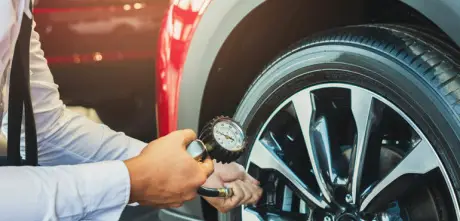
If you're a car enthusiast, a tire safety checklist is always on your mind. Your safety and your vehicle's best performance depend on two things: your knowledge of primary tire care and its implementation. Use the article below as a refresher of the tire inspection checklist that contains nine essential steps to maintain the efficiency and safety of your tires.
Step 1: Check Air Pressure
Proper air pressure ensures longer-lasting tires and efficient mileage with fuel. So, it is recommended by the experts to have a pressure-gauge at one's place all the time. But of course, if you can't buy it, then have the air pressure checked at the local tire retailer frequently. This tire inspection checklist step is free!
Check the air pressure of all the tires, and check them when they're cold. They either haven't run for a mile or are resting for more than 3 hours by cold.
Step 2: Check Tire Tread
Tread is another vital factor to check before you set up on a journey. It is crucial because, without proper treads, you might lose control of the vehicle. A Penny test during tire inspection checklist is helpful. You stick a penny in a tread with Lincoln's head facing down. If Lincoln's crown is visible, hurry up and get new tires.
Step 3: Different Tire Rotation Patterns
This is an exciting tire inspection checklist step to get the most out of your tires. You might want to rotate your tires with the following possibilities:
- Bringing rear tires to the front and vice versa
- Switching tires in a diagonal fashion
- It is recommended to rotate tires after every 5000 to 6000 miles.
Step 4: Tire Balancing and Wheel Alignment
Tire balancing is essential to increase the comfort level with the tires and also reduce road vibration. At the same time, wheel alignment makes your head in a straight direction saving you from drifting or pulling.
Step 5: Check for Irregular Wear
Tires wear out over time. Usually, when a tire wears down, the tread diminishes evenly. But sometimes there are irregular wear patterns which may include:
- Over-inflation: Tire wear down at the center
- Under-inflation: Tires wear along the shoulders
- Flat-spot wear: Sudden breaks resulting in long skid marks may cause flat spots on the tire
- Feathering & Cupping: It may be caused by cornering hardly or out-of-order suspension parts.
During this tire inspection checklist step, it’s best to consult a mechanic.
Step 6: Matching Replacement Tires
Whenever you replace old tires with new ones, it is always desirable to pick the same ones. The company installed these tires in the first place because it suits your vehicle the best.
Step 7: Don't Forget to Replace Your Spare
Temperature, air pressure, and other factors impact your spare even if you're not using it. The rubber can lose its elasticity, the microscopic pores could enlarge, the surface might crack, so it’s better to constantly update your spare tire as well, i.e., just in case.
Step 8: Don't Just Rely on Your TPMS System
TPMS is an absolute delight as it continuously guides one about the condition of tires. But experts recommend checking the tires manually too. This tire inspection checklist step shouldn’t be done frequently, but not less than once a month.
Step 9: Drive Patiently
Go easy, be calm, composed, and clinical while you drive. Don't hassle, panic, and don't fluctuate speed hastily because it affects your tires. Don't pull brakes too hard or fool around because these tires are worth all the care.
Same articles

Understanding Vehicle Inspection and Verification Services: Why They Matter for Every Driver
GuidesVehicle inspection and verification services are an essential but often overlooked part of keeping roads safe and cars legally compliant. Most people only think about inspections when it’s...
KLIFEX Brand Overview: High-Quality Automotive Repair Kits for Affordable Repairs
GuidesThe automotive aftermarket has long needed solutions that combine reliability, durability, and affordability. Many car enthusiasts and services are looking for a way...
Fast, Reliable Vehicle Emissions & Inspection Services Made Simple
GuidesFast, reliable emissions and inspection services are essential for keeping vehicles road-ready, compliant with environmental regulations, and safe for daily driving. If you’re looking for quick...

